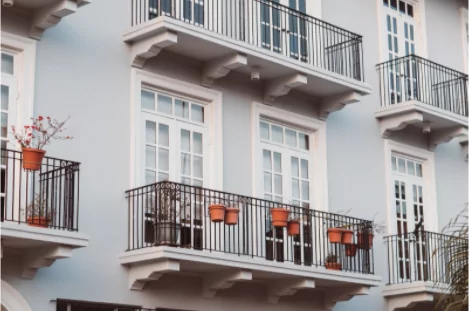With the average U.S. rent reaching $1,980 in February 2025—a 3.5% increase from the previous year—determining the right security deposit amount is more crucial than ever. Set it too low, and you risk being unprotected against potential damages. Set it too high, and you may scare off prospective tenants or even violate local regulations.
This guide breaks down how much to charge for a security deposit, what the typical cost is in the U.S., legal considerations, and market trends affecting deposit amounts.
Key takeaways
- Landlord security deposits typically range from one to three months’ rent, depending on state laws.
- State regulations may limit deposit amounts and enforce return deadlines.
- Landlords may increase deposits for high-risk tenants (e.g., poor credit, prior evictions).
- Luxury rentals often require higher deposits (two to three months’ rent).
- Legal penalties apply if landlords charge over state-allowed limits.
How much is a security deposit usually?
A security deposit is typically one to two months’ rent, but the exact amount varies based on state laws. Some states enforce maximum limits, while others allow landlords to set custom rates. Here’s a general breakdown:
- 1 month’s rent: Common in most states and preferred by landlords in competitive rental markets.
- 1.5 to 2 months’ rent: More frequent in high-cost areas or for furnished rentals.
- Flat-rate deposits: Some landlords charge a fixed amount (e.g., $500 or $1,000) rather than tying the deposit to rent.
Example: If a tenant rents an apartment for $1,500 per month, the security deposit could be $1,500 (one month’s rent) or $3,000 (two months’ rent in high-demand areas).
Banking Built for Real Estate Businesses
Open unlimited accounts for properties and security deposits with no monthly fees.
Factors that influence security deposit amounts:
- State laws: Some states cap the amount (e.g., California limits security deposits to 1x monthly rent or two months for landlords who own two properties).
- Property type: Luxury rentals and single-family homes often require higher deposits due to higher rent prices and private landlords who can’t offset risk like companies can for apartment complexes.
- Furnished rentals: Typically require higher deposits due to increased risk of damage. Some states, like Delaware, have no specific limits for furnished units.
- Tenant risk: Tenants with lower credit scores or past evictions may require higher security deposits.
- Market trends: Competitive rental markets may see lower or waived deposits for rent concessions to attract tenants.
Security deposit charges for risky tenants
Some landlords adjust deposit amounts based on tenant risk factors. You should consider increasing the security deposit if a tenant:
- Has a low credit score or no credit history
- Has a history of late rent payments
- Has no rental history or positive references
- Has prior evictions (3.6 million eviction cases are filed in the U.S. per year)
That said, not every applicant with one of these red flags is automatically a high risk. It’s important to consider their entire profile to fairly evaluate their suitability as a tenant.
Example: A tenant who has limited credit history but a steady income and great employer references may still be a good fit without charging extra for a deposit. In these cases, it’s worth exploring alternative ways to reduce your risk.
Alternative solutions for high-risk tenants:
- Require a co-signer: A financially stable co-signer provides extra security to cover rent or damages if the tenant defaults.
- Charge higher rent: Increase monthly rent prices instead of charging a larger security deposit.
- Use security deposit alternatives: Reduce upfront costs while protecting your assets with security deposit alternatives like deposit insurance or surety bonds (non-refundable premiums paid by tenants) and monthly installment payments.
Security deposit limits by state
Landlord-tenant laws for security deposits in the United States vary by state and local jurisdictions, which may impose additional rules or limits. Below is a table summarizing the maximum tenant deposit charges for all 50 states.
| State | Maximum Security Deposit |
|---|---|
| Alabama | 1 month’s rent |
| Alaska | 2 or 3 months' rent (except for units renting for more than $2,000) |
| Arizona | 1.5 months' rent |
| Arkansas | 2 months' rent |
| California | 1 to 2 month's rent |
| Colorado | 2 month's rent |
| Connecticut | 2 months' rent (1 month for tenants 62 years of age or older) |
| Delaware | 1 month's rent |
| Florida | No statutory limit |
| Georgia | 2 months' rent |
| Hawaii | 1 month's rent |
| Idaho | No statutory limit |
| Illinois | No statutory limit |
| Indiana | No statutory limit |
| Iowa | 2 months' rent |
| Kansas | 1 or 2 month's rent (depends on furnishing and pets) |
| Kentucky | No statutory limit |
| Louisiana | No statutory limit |
| Maine | 2 months' rent |
| Maryland | 2 months' rent |
| Massachusetts | 1 month's rent |
| Michigan | 1.5 months' rent |
| Minnesota | No statutory limit |
| Mississippi | No statutory limit |
| Missouri | 2 months' rent |
| Montana | No statutory limit |
| Nebraska | 1 month's rent |
| Nevada | 3 months' rent |
| New Hampshire | 1 month's rent |
| New Jersey | 1.5 months' rent |
| New Mexico | 1 month's rent (leases under 1 year); no limit for longer leases |
| New York | 1 month's rent |
| North Carolina | 2 months' rent (leases over 2 months); 1.5 months' rent (month-to-month) |
| North Dakota | 1 or 2 months’ rent (depends on pets or criminal history) |
| Ohio | No statutory limit |
| Oklahoma | No statutory limit |
| Oregon | No statutory limit |
| Pennsylvania | 2 months' rent |
| Rhode Island | 1 month's rent |
| South Carolina | No statutory limit |
| South Dakota | 1 month's rent |
| Tennessee | No statutory limit |
| Texas | No statutory limit |
| Utah | No statutory limit |
| Vermont | No statutory limit |
| Virginia | 2 months’ rent |
| Washington | No statutory limit |
| West Virginia | No statutory limit |
| Wisconsin | No statutory limit |
| Wyoming | No statutory limit |
Legal considerations for charging over the state-specific lease deposit limits
Charging tenants a security deposit that exceeds state-specific limits can have serious consequences, including:
Legal penalties and fines
- Violation of state laws: Many states have strict security deposit caps, and overcharging can result in legal action for reimbursement.
- Fines and monetary penalties: You may be required to pay double or triple the deposit amount for additional damages set by the court.
Tenant lawsuits and legal action
- Small claims court cases: Tenants can sue you in Small Claims Court for violating state laws on security deposit limits, return deadlines, and unjustified or undocumented deductions.
- Legal fees and court costs: Landlords may have to pay attorney fees if found guilty of overcharging or wrongfully withholding security deposits.
According to a 2024 Zillow survey, 41% of renters report having at least one move-out disagreement over costs for repairs, damages, maintenance, or utility payments.
Best practices for security deposit compliance
- Regularly review your state and local landlord-tenant laws for security deposits.
- Keep clear records of collected deposits, leases, security deposit deductions, and tenant communications to defend your decisions in case of disputes.
- Clearly outline your deposit policies and procedures in lease agreements to ensure tenants understand deposit requirements, deduction conditions, and return timelines.
- Use a separate security deposit savings account or an escrow account for security deposits in states that require this.
- Consult an attorney for clarity about legal obligations and specific deposit regulations.
Taking these steps will help you avoid legal problems, maintain good tenant relationships, and ensure smooth management of lease deposit charges.
Benefits of charging reasonable tenant lease deposits
Charging a reasonable and legally compliant move-in deposit benefits both you and your tenants. Here’s how:
Attracts more tenants and reduces vacancy rates
- Affordable move-in costs make it easier for tenants to rent the property.
- More applicants mean landlords can choose high-quality tenants from a larger pool.
- Lower vacancy periods lead to consistent rental income.
Example: If similar properties require $3,000 deposits but you charge $1,500, more renters will apply, reducing your time to fill vacancies.
Ensures legal compliance and avoids penalties
- Prevents violations of state laws that limit security deposit amounts.
- Avoids legal disputes that could result in fines, lawsuits, or forced refunds.
- Reduces tenant complaints to housing authorities and fair housing boards.
Example: California caps deposits at one or two months’ rent, depending on the number of properties and units. Charging more can lead to tenant lawsuits or government action.
Builds trust and positive tenant relationships
- Fair deposits show honesty and transparency, fostering tenant trust.
- Charging reasonable deposits helps create a sense of fairness, which can encourage tenants to stay longer and support more positive communication throughout the lease.
Reduces tenant turnover and saves money
- Lower deposits encourage lease renewals, reducing the need to find new tenants.
- Retaining tenants minimizes turnover costs for advertising, screening, and cleaning expenses (ranging between $1,000 to $5,000).
- Less frequent turnover means fewer maintenance and repair costs between leases.
Protects landlord reputation and increases referrals
- Positive tenant experiences lead to better online reviews on Zillow, Google, and Yelp.
- Satisfied tenants recommend properties to friends and family.
Example: Landlords with fair deposit policies often see higher occupancy rates and word-of-mouth referrals.
Encourages responsible tenants
- A fair deposit still motivates tenants to care for the property.
- Balances risk for both landlords and renters.
- Encourages lease compliance while keeping costs reasonable.
Example: A well-structured lease ensures tenants are accountable for damage, even with a lower deposit.
Security deposit charge trends: What’s changing?
Recent data indicates that eviction filings have surged in certain states, reaching levels 50% higher than pre-pandemic figures. This uptick is attributed to a combination of rising rents, a shortage of affordable housing, stagnant wages, and increased cost of living.
In response to these challenges, some landlords are adopting more flexible security deposit options to attract high-quality tenants who have steady income but limited cash on hand to cover large upfront deposits. These options include:
- Non-refundable move-in fees: A one-time, non-refundable fee covering move-in costs that’s typically lower than traditional deposits.
- Security deposit insurance: Tenants pay a small monthly premium to a third-party insurer, covering potential damages or unpaid rent.
- Installment payment plans: Allows tenants to pay the security deposit in installments over several months.
A recent study from Apartment List found that 56% of landlords offer at least one deposit alternative. These developments reflect a broader shift towards more tenant-friendly practices in the rental market.
Tip: Regardless of the security deposit amount or how you collect it, always conduct thorough tenant screening. Verifying income, running credit and background checks, and checking references help minimize risk and protect your investment.
Collect and return security deposits with Baselane
Once you’ve decided on the deposit amount and signed a lease, keeping that money organized is just as important.
Baselane makes it easy to set up separate accounts and start collecting security deposits and rent payments online in a matter of minutes. Plus, you can screen tenants, e-sign leases, and automate bookkeeping and tax packages (plus more) all in the same place for complete control over your cash flow without all the extra admin.
Ready to get started? Open a free security deposit account today.
FAQs
When deciding how much to charge for a security deposit, landlords typically ask for one to two months' rent. The exact amount can vary based on factors such as state laws, tenant’s credit history and employment, and market competition. Always check your state regulations for deposit limits and requirements for holding security deposits in a separate landlord bank account.
When determining the right lease deposit charge, landlords should consider local and state laws, tenant risk factors (such as credit history, employment stability, and rental history), and the local rental market. Charging a reasonable deposit helps attract reliable tenants and minimizes vacancy periods.
In California, the maximum rental security charge a landlord can require is one month's rent. Landlords with up to two rental properties (four units total) can charge two times the monthly rent. To stay compliant, always issue a security deposit receipt and provide a security deposit refund letter that outlines any deductions made.
The average lease security payment in the U.S. is around one month’s rent, though this varies significantly based on local rental markets and tenant risk factors. Higher-end properties or tenants considered higher risk may require deposits of two months' rent or more. Certain states have security deposit caps, limiting the amount you can charge. Also, check if your state requires a separate bank account for Airbnb or long-term rental properties to hold security deposits.
The amount you charge for a security deposit may vary depending on several factors, including the property’s amenities (like recent upgrades), monthly rent, overall property value, and how competitive the local rental market is. You should also consider state security deposit laws. If a prospective tenant has poor credit or a history of late rent payments, you may want to require a higher deposit to offset potential risk.








